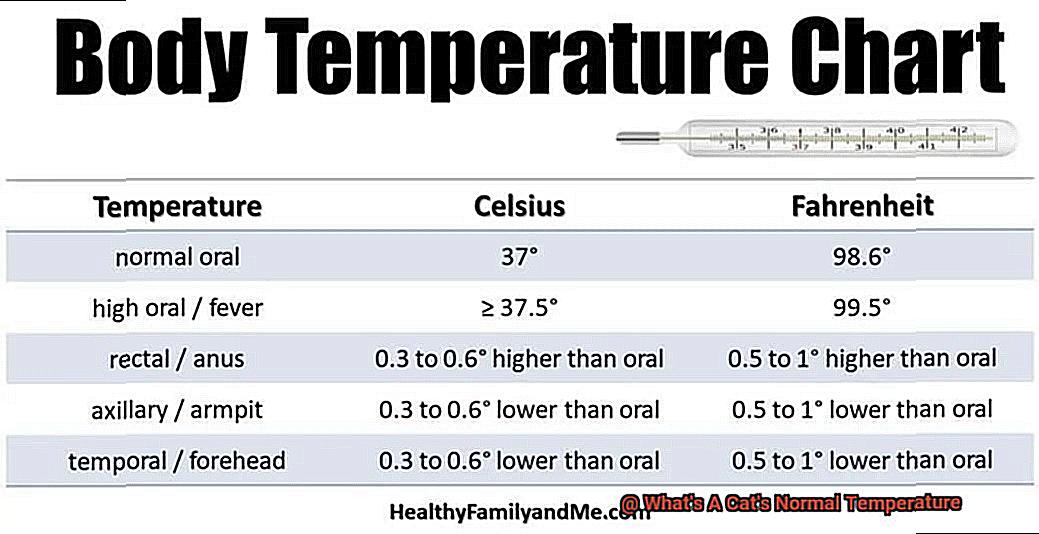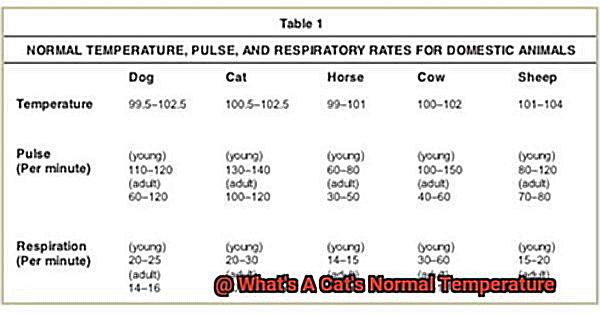Calling all cat enthusiasts.
Have you ever wondered what the normal body temperature is for your beloved feline? As we gaze upon our furry friends, it’s crucial to keep a close eye on their health and well-being.
Monitoring their body temperature can be an early warning sign of illness. So, what is considered a cat’s normal body temperature?
Unlike humans, cats have a higher range of normal body temperatures, typically between 100.5 to 102.5 degrees Fahrenheit. Knowing this range is essential because any significant increase or decrease in temperature could indicate an underlying health issue that requires immediate attention.

Aside from keeping tabs on their temperature, cat owners should also be mindful of any signs of discomfort or unusual behavior, such as lethargy or loss of appetite. When in doubt, it’s always best to consult with a veterinarian since our feline friends can’t communicate the problem directly.
In this blog post, we’ll delve into everything you need to know about your cat’s normal body temperature and how it impacts their overall health. We’ll explore the underlying causes of fluctuations in temperature and provide tips on how to monitor and maintain your kitty’s well-being.
So, let’s jump in and ensure our cats are feeling purrfect.
Factors That Affect Your Cat’s Normal Temperature
A cat’s normal body temperature ranges from 100.4°F to 102.5°F (38°C to 39.2°C).
However, several factors can affect your cat’s temperature, causing it to deviate from the normal range. Firstly, age is a significant factor that can impact a cat’s body temperature.
Kittens have underdeveloped systems and are more susceptible to hypothermia because they cannot regulate their body temperature as effectively as adult cats. On the other hand, older cats may have a lower body temperature due to decreased metabolic activity.
Illness or injury can also cause changes in your cat’s temperature. A fever is a common sign of an underlying illness, and it causes the body temperature to rise above the normal range.
Conversely, shock or hypothermia can cause a drop in body temperature. If you notice any changes in your cat’s behavior or unusual symptoms such as lethargy, loss of appetite or vomiting, it’s best to consult with your veterinarian right away.
Environmental factors such as hot or cold weather can also affect your cat’s body temperature. During hot weather, your kitty may become overheated and develop hyperthermia, while cold weather can cause hypothermia.
Make sure to provide your cat with a comfortable environment that suits their needs and keep them well-hydrated during peak temperatures. Stress or anxiety can also affect your cat’s body temperature.

When feeling stressed or anxious, a cat may experience an increase in heart rate and respiratory rate, which can lead to an elevated body temperature. If you suspect stress is affecting your cat’s health or behavior, try to eliminate the source of stress and provide plenty of love and affection.
To conclude, several factors can affect your cat’s normal body temperature. As a loving pet parent, it’s crucial to monitor your cat’s temperature regularly and seek veterinary attention if you notice any significant changes.
Why Taking Your Cat’s Temperature is Important

Cats are masters at hiding their pain, and they cannot communicate when something is wrong. Taking your cat’s temperature is one of the best ways to monitor their health and detect any issues early on. A normal body temperature for a cat is between 100.5°F and 102.5°F (38°C and 39.2°C).
If your cat’s temperature falls outside of this range, it could indicate an underlying health issue that needs to be addressed by a veterinarian.
By monitoring your cat’s temperature regularly, you can help ensure that they stay healthy and happy for years to come.
How to Take Your Cat’s Temperature
Taking care of your furry friend’s health is vital, and one way to do so is by monitoring their temperature. If you’re a pet owner, you may wonder how to take your cat’s temperature.
This task can seem daunting, but it doesn’t have to be. In this blog post, we’ll cover everything you need to know about taking your cat’s temperature, from why it’s important to the tools needed and the steps to follow.
The Right Tools for the Job
To take your cat’s temperature, you will need a digital rectal thermometer specifically designed for pets. Using lubrication such as petroleum jelly or a water-based lubricant can make the process smoother and more comfortable for your cat. It is essential to use a thermometer designed for cats as human or glass thermometers can break or cause injury to your furry friend.
How to Take Your Cat’s Temperature
Before attempting to take your cat’s temperature, it is important to have the right tools and techniques. First, prepare your cat by making sure they are calm and relaxed. You may want to have another person hold them during the procedure.
Gently lift their tail and insert the thermometer into their rectum about an inch deep. Hold onto the thermometer securely so that it does not get lost inside your cat, and leave it in place for at least one minute or until you hear a beep if using a digital thermometer.
Monitoring Your Cat’s Behavior
After taking your cat’s temperature, it is important to monitor their behavior for any signs of discomfort or distress. You may notice that your cat seems agitated or restless after taking their temperature.
This is normal and should subside quickly. However, if your cat continues to show signs of discomfort or if their temperature remains abnormal, it is important to seek veterinary attention.
When to Seek Veterinary Attention
If your cat’s temperature falls outside of the normal range or if you notice any other abnormalities in their behavior, it is important to seek veterinary attention immediately. A high temperature, known as a fever, can be a sign that your cat’s body is trying to fight off an infection.

Warning Signs of Abnormal Temperatures
One crucial aspect of your cat’s health is their body temperature.
A cat’s normal temperature ranges from 100.5 to 102.5 degrees Fahrenheit. Any temperature outside of this range could be a sign of an underlying health issue or infection.
To keep your cat in tip-top shape, it’s essential to know the warning signs of abnormal temperatures. One of these signs is lethargy.
If your normally active cat seems to be sleeping more often than usual or has less energy, it could be a red flag for an underlying illness. Another warning sign is shivering or shaking, as this could indicate that your cat is trying to regulate their body temperature.
It’s also crucial to observe your cat’s eating habits. If they’re experiencing a lack of appetite, vomiting, diarrhea, or rapid breathing, it could be a sign of a high fever or other underlying health issues.
In such cases, it’s vital to take your cat to the veterinarian as soon as possible for prompt medical attention. Regularly monitoring your cat’s temperature is also essential, particularly if they have a history of health issues or infections.
You can use a digital thermometer to take your cat’s temperature rectally and contact your veterinarian immediately if you notice any abnormalities. Remember, being aware of the warning signs of abnormal temperatures in cats is crucial for maintaining their overall health and wellbeing.
By paying close attention to your cat’s behavior and taking their temperature regularly, you can catch potential health issues early on and seek prompt medical attention when necessary.
High Temperature (Fever) in Cats
One way to do so is by monitoring their temperature regularly.
A cat’s normal temperature ranges from 100.5°F to 102.5°F (38°C to 39.2°C). However, if your cat’s temperature rises above this range, it could be a sign of fever, which can be caused by a variety of factors such as infection, inflammation, cancer or autoimmune diseases.
Fever can be harmful if left untreated, so it is important to keep an eye out for symptoms such as lethargy, loss of appetite, dehydration, shivering, rapid breathing, and increased heart rate. If you notice any of these signs in your cat, seek veterinary care immediately.
Your veterinarian may recommend treatment options such as antibiotics or anti-inflammatory medications depending on the underlying cause of the fever. It is crucial to follow their advice closely and monitor your cat’s temperature regularly until they have fully recovered.
In addition to seeking veterinary care and following their recommended treatment plan, there are preventive measures that you can take at home to help keep your cat healthy.
Ensure that your cat is up-to-date on their vaccinations and parasite prevention medications, provide them with clean water at all times, feed them a balanced diet, and give them opportunities for exercise and mental stimulation.
Low Temperature (Hypothermia) in Cats
Unfortunately, sometimes things can go wrong, and your cat might experience low body temperature, also known as hypothermia.
This can be a life-threatening condition if left untreated, so it’s essential to know the causes, symptoms, and treatments for hypothermia in cats. Hypothermia occurs when a cat’s body temperature drops below the normal range of 100.4 to 102.5°F (38 to 39.2°C), with temperatures below 99°F (37.2°C) being considered hypothermic.
Exposure to cold temperatures for an extended period or prolonged anesthesia can trigger hypothermia in cats. Additionally, certain medical conditions such as diabetes, kidney disease, or hypothyroidism can increase the risk of hypothermia in cats.
The symptoms of hypothermia in cats are easy to spot if you know what to look for. Your cat may shiver, appear lethargic and weak, have a decreased heart rate and breathing rate, and have pale or blue gums.
If you notice any of these symptoms in your cat, it’s crucial to seek veterinary care immediately. The treatment for hypothermia in cats involves warming your cat up gradually.
You can do this by wrapping your cat in blankets or towels and providing a warm environment such as a heated room. However, it’s important not to use heating pads or hot water bottles as they can cause burns.
Your veterinarian may also provide intravenous fluids and medications to help raise your cat’s body temperature. Preventing hypothermia in cats involves being proactive and taking preventative measures such as keeping them warm and dry during cold weather and providing a warm shelter for outdoor cats.
Avoiding prolonged anesthesia when possible can also reduce the risk of hypothermia in cats. Regular veterinary check-ups are essential as they can help identify potential medical conditions that may increase the risk of hypothermia.
Knowing the causes, symptoms, and treatments for hypothermia in cats can help you identify this condition early on and seek appropriate treatment.
The Importance of Monitoring Your Cat’s Temperature
In this section, we will delve into why monitoring your cat’s temperature is crucial and what can happen if you don’t.
Firstly, monitoring your cat’s temperature can be an early indicator of illness. A cat’s normal body temperature ranges from 100.5°F to 102.5°F.
Any temperature higher or lower than this range could indicate an underlying health issue. For example, a high temperature could signify fever, infection, or inflammation, while a low temperature could indicate hypothermia or shock.
By keeping an eye on your cat’s temperature, you can catch any changes early and seek veterinary care before the condition worsens. Secondly, certain medications and procedures can impact a cat’s body temperature.
That’s why monitoring it closely can help prevent any complications that may arise during treatment or after surgery. Lastly, monitoring your cat’s temperature can help you track their overall health and wellness.
By keeping a record of your cat’s temperature over time, you can identify any patterns or changes that may indicate a developing health issue. This information can be invaluable to veterinarians when diagnosing and treating your cat.
In conclusion, monitoring your cat’s temperature is an easy but critical part of being a responsible pet owner. By doing so, you can ensure that your furry companion stays healthy and happy for years to come.
xTQXW8KmUOA” >
Conclusion
One crucial aspect of their health is their body temperature. A cat’s normal body temperature ranges from 100.5°F to 102.5°F, and any significant increase or decrease could be an early warning sign of illness.
Don’t panic if you need to take your cat’s temperature – it’s easier than you think. Using a digital rectal thermometer specifically designed for pets and following the right techniques can help you monitor your cat’s temperature at home.
Factors such as age, illness, injury, environmental factors, and stress can all affect your cat’s body temperature. By regularly monitoring their temperature, you can catch potential health issues early on and seek prompt medical attention when necessary.
If you notice any warning signs like lethargy, shivering or shaking, lack of appetite, vomiting, diarrhea or rapid breathing in your furry friend, it’s time to call the vet immediately. These symptoms could indicate abnormal temperatures that require urgent medical attention.
To sum up, being a responsible pet owner means taking care of every aspect of your kitty’s well-being – including their body temperature.







